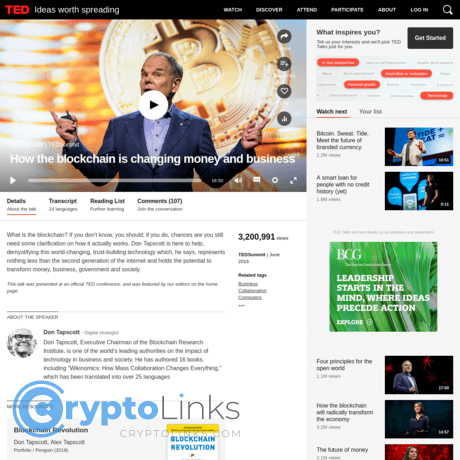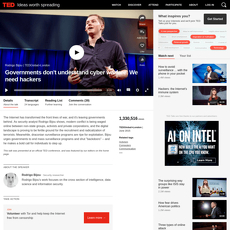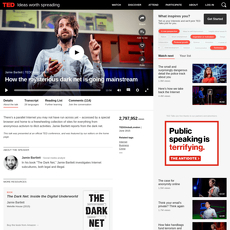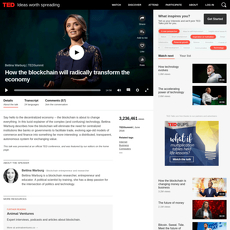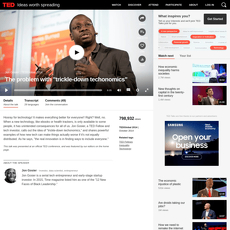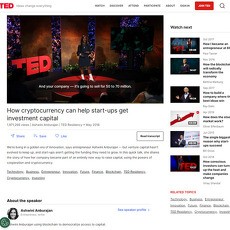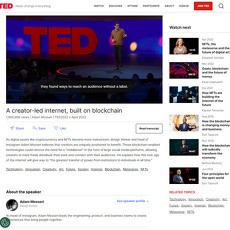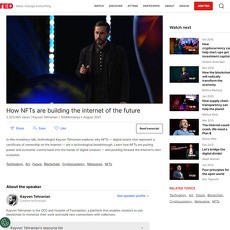Don Tapscott: How the blockchain is changing money and business Review
Don Tapscott: How the blockchain is changing money and business
www.ted.com
Don Tapscott on Blockchain: How It’s Changing Money and Business (TED Talk Breakdown + Real Answers)
Ever watch a TED Talk, feel fired up, and then think, “Cool… but what do I actually do next?”
That’s exactly why I wrote this. Don Tapscott’s talk, How the blockchain is changing money and business, nails the big picture. My goal here is to turn that energy into clarity you can use—without the fluff, hype, or crypto buzzwords that scare teams off.
“The technology likely to have the greatest impact on the next few decades has arrived… It’s called the blockchain.”
— Don Tapscott, TED
Too much noise, not enough clarity
Let’s be honest about why most people stall out on blockchain:
- Blockchain = speculation? When headlines scream about prices, real value gets lost. Meanwhile, cross-border payments still take days and cost too much. The World Bank tracks global remittance fees that often sit well above 6%—that’s painful overhead for families and businesses alike.
- Jargon overload. Blocks, nodes, keys, consensus… most guides either go full technical or stay vague. Neither helps you ship anything.
- Business risk worries. Leaders ask, “Where do we even start?” They see fraud, chargebacks, reconciliation hell, and compliance headaches—but not the on-ramps to fix them. Cross-border improvements are a G20 priority for a reason: today’s rails are slow, costly, and opaque (BIS overview).
- Use cases exist—buried under noise. Faster settlement, fewer intermediaries, cleaner audits, and better traceability are real. Walmart publicly tested food traceability on blockchain and cut recall trace time from days to seconds (IBM Food Trust).
- “Who actually moves money on-chain?” It’s not obvious. People hear about miners, validators, wallets, and exchanges, but the roles are fuzzy, so teams hesitate.
If any of that sounds familiar, you’re in the right place.
What I’m going to give you
Inspired by Tapscott’s core message, I’ll keep it practical and specific:
- Plain-English answers to the questions people actually ask: how blockchain changes money and business, how value moves on-chain step by step, and who does what when you press “send.”
- Clear starter paths you can try with low risk—like using stablecoins for faster B2B settlement or testing a simple smart contract for payouts.
- Real examples you can point to in a meeting, not just theory. Where possible, I’ll link to public sources so you can back up your plan.
- Guardrails to avoid rookie mistakes: security basics, compliance considerations, and where not to cut corners.
I want you to leave with a short list of actions—not a longer list of buzzwords.
Who this is for—and why it’s worth your time
This is for you if:
- You’re crypto-curious and want to understand the point of blockchain without becoming a programmer.
- You run a business or a product team and care about faster payments, fewer disputes, and less back-office chaos.
- You’re exploring new models—like tokenized rewards, on-chain royalties, or shared data for audits—and you want the shortest path to a credible pilot.
Why it’s worth the read:
- Efficiency is real: instant or near-instant settlement on modern networks can replace days-long waits and reduce reconciliation work.
- Transparency reduces disputes: shared ledgers cut “who has the latest version?” fights across supply chains and finance.
- Programmability unlocks automation: smart contracts can handle payouts, escrows, and SLAs with fewer errors and lower overhead.
And if you’ve been burned by hype before, good—bring that skepticism. I’ll show what’s working now, what to avoid, and where the credible wins are.
Ready for the simple version of Tapscott’s big idea—and the real-world changes it points to? In the next section, I’ll break down blockchain as the “trust layer” of the internet in plain English, then connect it directly to money and business moves you can test. Want the cleanest explanation you’ve heard all year?
Don Tapscott’s big idea in plain English: Blockchain as the trust layer of the internet
“The next era of the internet isn’t about sharing information—it’s about exchanging value with trust built in.”
When Tapscott says “blockchain is a trust protocol,” here’s what I hear: we finally have a way to move money, rights, and rules across the internet without asking a middleman to vouch for us. The blockchain acts like a shared, tamper-resistant ledger that anyone can check, but no one can quietly rewrite. That simple shift—shared truth instead of private databases—unlocks faster payments, cleaner audits, programmable agreements, and new ways to reward people and partners.
If the first internet broke the bottleneck on information, this one breaks the bottleneck on trust. That’s not hype; it’s a new foundation.
Quick refresher: what a blockchain is (no fluff)
Think of a blockchain as a public spreadsheet that:
- Stores data in blocks (batches of transactions) chained together chronologically.
- Lives on many computers (nodes) that all keep a copy and check one another.
- Locks entries with cryptography, so changing old data would mean rewriting the entire chain—practically impossible.
- Uses public/private keys: your public key is like your account number; your private key is your secret signature that proves “it’s really me.”
Result: a shared database anyone can verify and no single party controls. Once something’s recorded, it’s extremely hard to alter without everyone noticing.
How it changes money
Money on the internet used to be patched together with card networks, banks, and batch settlements. Blockchain flips that into real-time, peer-to-peer value movement, with software enforcing the rules.
- Peer-to-peer payments without card gateways or bank cutoffs. Send value directly to an address—24/7, globally.
- Programmable money with smart contracts. Escrow, splits, royalties, and schedules run automatically once conditions are met.
- Lower fees, fewer chargebacks for merchants. Final settlement happens on-chain, not weeks later in reconciliation spreadsheets.
- Stablecoins as the bridge to everyday commerce. Dollar-pegged tokens like USDC/PYUSD move like crypto but feel like cash in/out.
This isn’t theoretical. Stablecoins already settle trillions in on-chain volume each year (see Visa’s crypto dashboard for the curve), and payment leaders are tapping in:
- Visa expanded stablecoin settlement to Solana and works with acquirers like Worldpay and Nuvei (Reuters).
- Stripe reintroduced crypto payments with USDC on multiple chains to help internet businesses get paid globally (Stripe).
And the need is obvious. The average cost to send money across borders hovers around 6%—painfully high for families and small businesses (World Bank). Stablecoin transfers can cut that dramatically while settling in minutes or seconds, depending on the chain.
How it changes business models
When the ledger is shared and programmable, you don’t just move money faster—you restructure how you work with partners and customers.
- Transparent supply chains: put “who made what, when” on a common ledger. Less dispute, faster recalls, easier financing.
- Automated agreements: smart contracts release payments on delivery, service levels, or time—no manual chasing.
- Tokenized assets: convert rights (invoices, loyalty, seats, IP) into digital tokens that can be owned, transferred, and audited on-chain.
- New incentive systems: reward the exact behaviors that grow your network—contributors, validators, curators—without piling on middlemen.
Proof it works shows up where transparency was broken. Food traceability is the classic example: Walmart reported cutting mango trace times from nearly a week to seconds using a blockchain system for suppliers (IBM Food Trust). That’s not just a nice dashboard—it reduces waste, risk, and legal exposure.
In finance, shared ledgers reduce reconciliation. Stablecoin issuers publish reserve attestations and let anyone verify circulating supply on-chain (USDC). In connectivity, network projects use tokens to reward building coverage where it’s needed, turning users into co-owners rather than just customers.
Real-world snapshots
Here are current, useful patterns I see translating Tapscott’s “internet of value” into everyday wins:
- Payments and remittances
Families and contractors use stablecoins to move dollars globally with less friction, then cash out locally. The World Bank tracks traditional remittance fees above 6%; stablecoin rails are often a fraction of that with near-instant settlement (data). - On-chain invoices
Teams issue invoices payable in stablecoins with automatic reconciliation. Tools like Request Finance support multi-token billing, approvals, and accounting exports so finance doesn’t live in spreadsheet hell. - Provenance in supply chains
Retailers and food companies trace origin, batch, and handler events on a shared ledger, cutting recall time and dispute rates (see IBM Food Trust). - Digital identity for onboarding
Partners and users share verifiable credentials (W3C standard) issued by trusted sources—think “KYC completed on X date by Y bank”—without exposing raw personal data. Verifiable, privacy-preserving, and reusable across services (W3C). - Creator payouts and royalties
Smart contracts split revenue instantly to collaborators, accountants get clean on-chain records, and fans can hold access tokens that unlock perks. Music platforms and NFT marketplaces have shown this at scale; the key is programmatic splits that run the same way every time.
Zoom out and a pattern emerges: blockchain turns “trust” from meetings, emails, and gatekeepers into code, receipts, and shared state. You don’t need a PhD to use it—you just need to understand what happens when you press “send.”
Want the simple, no-jargon walkthrough of that moment—how a transaction actually moves from your wallet to the public ledger, what fees do, and when it’s truly final? You’re about to get exactly that. Ready to see what really happens behind the scenes when money moves on-chain?
How blockchain transfers money: the simple step-by-step
If you’ve ever sent a bank transfer and watched days go by, this will feel refreshingly direct. On a blockchain, money moves with math, not permission. Here’s the clean, no-jargon flow I use when I send value on-chain.
“We had an internet of information. Now we’re building an internet of value.”
From your wallet to the network
Every transfer starts with a wallet and two keys:
- Public address: your “account number” people can send to.
- Private key: your secret that proves you’re allowed to spend. It never leaves your wallet.
What happens when you hit Send:
- You enter the destination address and amount. Most wallets let you paste or scan a QR code to avoid typos.
- You pick a network fee. Pay more for faster inclusion, or less if you’re not in a rush.
- You sign the transaction locally. Your wallet uses your private key to create a unique signature. With hardware wallets, the signing happens on the device, offline.
- Your wallet broadcasts the transaction to the network. It lands in a public waiting room called the mempool. You get a transaction hash you can track on a block explorer like Etherscan or mempool.space.
A quick nuance you’ll see in explorers:
- Bitcoin (UTXO model): your transaction spends specific “coins” (inputs) and sends change back to you automatically.
- Ethereum and similar (account model): your balance goes down; no “change address.” You’ll also see a nonce—a counter that keeps your transactions in order.
Real-world example: I paid a contractor 200 USDC on Ethereum. I scanned their address QR, set a priority fee, signed, and grabbed the tx hash. No forms. No bank hours.
Validation and consensus
After broadcast, the network decides whether your transaction makes the cut:
- Full nodes verify the basics: is the signature valid? Are the funds there? Is the nonce correct? Is the transaction well-formed?
- Miners/validators pick transactions and order them into a block. They usually prefer higher-fee transactions first.
- Consensus locks it in:
- Proof of Work (PoW): Bitcoin miners compete with computing power; a block roughly every ~10 minutes.
- Proof of Stake (PoS): Ethereum, for example, has validators stake ETH and propose/attest to blocks; new blocks ~12 seconds.
- Once included in a block, your transaction is recorded on the public ledger.
Timings you’ll actually feel:
- Bitcoin: plan for ~10 minutes per confirmation; many services wait 1–3 confirmations (exchanges often 3–6 for larger amounts).
- Ethereum mainnet: block inclusion in ~12 seconds; economic finality later (more below). Many merchants accept 1–2 blocks for low-risk transfers.
- High-throughput chains (e.g., Solana): typical end-user finality in a few seconds with tiny fees.
Confirmations, fees, and finality
Three levers determine how fast and how “done” your transfer is:
- Fees:
- Ethereum: you pay gas for computation + storage. Since EIP-1559, there’s a base fee (burned) and a tip (your priority). Higher tips usually mean faster inclusion.
- Bitcoin: you pay sat/vByte based on transaction size in bytes, not value. A small-but-busy mempool can push fees up.
- Pro move: If you underpay, many wallets let you “speed up” the transaction. On Bitcoin, this is called RBF (Replace-By-Fee). On Ethereum, you resend with the same nonce and a higher max fee.
- Confirmations:
- Each new block that builds on your transaction is a confirmation.
- More confirmations = lower chance of a chain reorg that could bump your transaction out.
- Finality:
- Probabilistic (e.g., Bitcoin): risk shrinks with each block; 6 confirmations is the classic norm for high-value.
- Checkpoint/BFT-style (e.g., Ethereum, Cosmos chains): the network reaches a point where reverting is practically impossible without major collusion. On Ethereum, protocol-level finality arrives after a few epochs; day-to-day commerce often doesn’t wait that long.
- Reality check: once a transaction is finalized, it’s irreversible. No chargebacks. That’s why address verification and small test sends are worth the extra minute.
Sample outcomes I see often:
- Paying a supplier with USDC on Polygon: arrives in seconds; fees usually under $0.05.
- Sending BTC on a busy day: might take 30–60 minutes or more if you set a low fee and blocks are full.
Speed hacks: Layer 2s and cross-chain moves
When you need lower fees and faster UX, use the stack smartly:
- Layer 2 rollups (Ethereum):
- Optimistic rollups: Optimism, Base, Arbitrum. Cheap and fast for users; withdrawals to Ethereum take ~7 days via the canonical bridge (fraud-proof window). Many wallets and exchanges now offer “fast withdrawals” via liquidity providers.
- ZK rollups: zkSync Era, Starknet, Linea. Validity proofs allow quicker finality on L1 and generally low fees.
- Why it matters: you get near-instant UX with Ethereum-level security anchoring the system.
- Sidechains and alt L1s:
- Examples: Polygon PoS (sidechain), Solana, Avalanche, BNB Chain.
- Trade-offs: speed and cost vs. different security/governance models. Great for consumer-scale apps and microtransactions.
- Bridges and cross-chain swaps:
- What they do: move value across chains when apps or users aren’t on the same network.
- Risks: cross-chain bridges have been prime targets. In 2022, bridge exploits accounted for a large share of total crypto stolen, with losses in the billions according to multiple forensic reports.
- Safer habits: prefer official or well-audited bridges; test with a small amount; confirm you’re transferring the native version of a token (e.g., native USDC) when possible; or use a reputable exchange as a “bridge” by withdrawing to the target chain.
Two quick, real examples from my week:
- Client payouts on Arbitrum: 20 USDC each to 30 recipients in under 2 minutes total, fees ~a few cents per recipient using a batch tool.
- USDC from Ethereum to Solana: I used a major exchange as the bridge: deposit on Ethereum, withdraw native USDC on Solana. Took minutes, removed smart contract risk from third-party bridges.
And yes, you can get clever:
- Approve once, pay many times: on EVM chains, approve a spending limit for a trusted app to avoid repeated approvals (just keep it tight to reduce risk).
- Use payment links and QR: many wallets generate a link with the exact amount and chain to cut mis-sends.
One last thing I tell every team: the person sending the money controls the fee and speed, but they don’t “push” it into anyone’s bank. The network confirms it, and the recipient’s wallet simply watches for the state change on-chain. Which raises the next big question: who actually makes that magic happen—humans, software, or the network’s guardians?
Who actually “moves” money on a blockchain?
Here’s the short version: no one “moves” your money for you—your signature does. The network simply checks, orders, and records that move. That clarity changes how we pay, get paid, and build products around payments.
“On-chain, nobody moves your money without your signature—and that’s the point.”
People and public addresses
Everything starts with people holding keys and controlling addresses. Think of it like this:
- Public address = your crypto “account number.” Shareable and safe to display. ENS names like yourname.eth or QR codes make it human-friendly.
- Private key/seed phrase = the “do not share” secret that authorizes movement. Lose it and you lose access. No “forgot password” button.
- You sign, then broadcast = your wallet creates a transaction, you sign it, and the network picks it up. No banker’s hours. No approval queue.
Real-world feel: Paying a contractor in USDC is as simple as scanning their QR and pressing send. The wallet shows the fee, estimated time, and finality. The magic isn’t in a bank clerk; it’s in your signature and the network’s global ledger.
Miners/validators and full nodes
These are the network’s referees and record-keepers. They don’t own your funds, can’t “reach in,” and don’t act like a bank teller.
- Miners/validators order transactions and write them to blocks. In Proof of Work (e.g., Bitcoin), miners compete with energy and hardware. In Proof of Stake (e.g., Ethereum), validators stake coins to secure the chain and earn rewards.
- Full nodes store and share the entire ledger, independently verifying every rule. They’re the consistency check that keeps everyone honest.
- They verify; you authorize. If your signature and balance are valid, your transaction gets included. If not, it’s ignored—no shortcuts, no favors.
Practical example: Send USDC on a fast chain like Solana and validators will include it within seconds; send on Bitcoin and miners include it in the next block on average ~10 minutes. Different rails, same principle—your signature is the key, the network is the notary.
Wallets, exchanges, and payment gateways
Most people don’t talk to nodes directly. Software and services make it usable:
- Wallets (e.g., Ledger, Trezor, MetaMask, Phantom) help you hold keys safely and sign the right transactions. Good wallets warn you about suspicious permissions and show readable payment details.
- Exchanges (e.g., Coinbase, Kraken) let you convert between fiat and crypto, and move funds on/off chain. They’re bridges to legacy rails.
- Payment gateways (e.g., Coinbase Commerce, BitPay, OpenNode) give merchants invoices, webhooks, automatic settlement to stablecoins or fiat, refunds, and disputes workflow.
Proof it’s real, not theoretical:
- Stripe reintroduced crypto payments in 2024 using USDC on modern chains, making on-chain checkout feel familiar to web businesses.
- Shopify merchants can add crypto checkout via Coinbase Commerce or BitPay—scan a QR, the gateway watches the chain, confirms payment, and triggers fulfillment.
Security reality check: according to Chainalysis, illicit crypto activity represented a small fraction of total volume (around 0.34% in 2023) while compliance tooling keeps improving. The tooling stack matters.
Stablecoin issuers and infrastructure players
When you pay in stablecoins, there’s an off-chain promise behind the on-chain token. That’s where issuers and infrastructure come in:
- Stablecoin issuers maintain reserves and handle mint/redemptions:
- USDC by Circle, with regular reserve transparency reports.
- USDT by Tether, with attestations and a market cap north of $100B.
- PYUSD by PayPal for consumer-friendly flows.
- DAI by Maker, an overcollateralized stablecoin governed on-chain.
- Settlement in the wild: Visa expanded USDC settlement with partners like Worldpay and Nuvei, moving actual merchant payouts over public chains.
- Oracles feed real-world and cross-chain data (e.g., Chainlink price feeds and proof-of-reserve) so automated payments don’t rely on guesswork.
- Custodians like Fireblocks, Anchorage Digital, and BitGo safeguard keys for teams that need institutional controls, policies, and insurance.
- Compliance and analytics from TRM Labs, Chainalysis, and Nansen help businesses block sanctioned addresses, monitor risk, and handle audits with an export instead of a scramble.
Put together, this cast makes “money movement” programmable. You authorize with a key. Validators confirm it. Wallets and gateways make it painless. Issuers, custodians, and compliance tools make it enterprise-ready.
So here’s the fun part: once you know who does what, you can pick winners for your stack—wallet, chain, stablecoin, settlement, analytics—and actually ship something that cuts cost and reconciles itself. Want the quickest wins businesses are testing right now—and exactly how to try them without betting the farm?
Where businesses can win: practical use cases to try first
“Speed is nice. Knowing the money actually arrived is better.”
Faster payments and smarter treasury
I keep meeting teams stuck with wire delays, surprise FX spreads, and “we’ll settle next week.” Stablecoins fix painful parts of that flow without forcing you into speculation.
- What to try: Use a regulated stablecoin (like USDC) for B2B invoices, affiliate payouts, or global contractor payments. Settlement can be near‑instant on fast networks with fees often under a cent.
- Why it matters: The World Bank puts average global remittance fees around 6%—and that’s before you factor in delays and chargebacks. On-chain settlement can chip away at both cost and uncertainty. Source: World Bank Remittance Prices.
- Proof it’s real: Visa expanded USDC settlement to Solana with partners like Worldpay and Nuvei, signaling mainstream rails are meeting crypto rails. Stripe also reintroduced crypto payouts with USDC support for merchants: Stripe crypto payments.
- Automation angle: Use smart contracts to trigger payouts when conditions are met (delivered, approved, or time-based)—no manual batch runs.
Starter steps:
- Pick a chain with low fees and strong ecosystem (e.g., USDC on Solana or Ethereum + an L2).
- Set up a corporate wallet with policy controls (multisig via Safe works well).
- Run a $50–$500 test payment to a trusted partner. Measure time-to-finality and total cost vs. your bank.
- For invoices, test Coinbase Commerce or BitPay to generate payable links and settle in crypto or fiat.
KPIs to watch: settlement time, total fees (%), FX spread, exceptions/chargebacks, and ops hours saved.
Supply chain and provenance
When everyone sees the same tamper-resistant timeline of a product’s journey, guesswork and disputes drop—and financing gets faster.
- What to try: Record key events (origin, handoff, storage, delivery) on a shared ledger. Add QR codes so customers or auditors can verify history instantly.
- Why it matters: Walmart’s famous mango test went from “trace in days” to “trace in seconds” using blockchain-based food traceability. IBM reported 2.2 seconds to find a product’s source in that pilot. Source: IBM Food Trust case study.
- Financing boost: Clear provenance and real-time data can speed invoice factoring. Platforms like Centrifuge tokenize receivables, helping borrowers access liquidity with on-chain transparency.
Starter steps:
- Pick one product line or lane (small, high-value works best at first).
- Agree on data fields and standards with suppliers (GS1 identifiers make life easier).
- Use a simple middleware or SaaS (e.g., “blockchain as a service”) to write events on-chain and expose a read-only portal.
- Add QR labels that link to a public proof page. Train your support team to use it in disputes.
KPIs to watch: time to trace, dispute rate, claims % recovered, days to financing, and chargebacks avoided.
Smart contracts for automation
Think of smart contracts as “financial workflows you can’t forget to run.” Once triggers hit, they pay out, split funds, or escrow—no chasing approvals.
- Escrow and milestones: Hold funds until delivery milestones are met. Release automatically when an oracle (system or verifier) confirms success.
- Revenue and royalty splits: Stream or split income the moment it lands. Tools like 0xSplits do this without a finance team babysitting spreadsheets.
- SLA-based payouts: Parametric models pay when metrics cross a threshold—no claims desk. Examples include weather and flight-delay insurance powered by oracles (see Etherisc and Chainlink case studies).
Starter steps:
- Pick one automation (escrow or split) with a clean, objective trigger.
- Use audited templates from OpenZeppelin. Keep it minimal.
- Set spend limits and use a multisig to approve deployments and upgrades.
- Run a sandbox test with tiny amounts before you touch production money.
KPIs to watch: manual touches removed, payout accuracy, close time, and disputes.
Identity, access, and onboarding
Verifiable credentials let you prove facts (KYC passed, NDA signed, training complete) without oversharing data. It’s privacy-first and portable.
- What to try: Use W3C Verifiable Credentials to issue partner badges or employee access proofs. Partners can reuse them instead of uploading the same documents again.
- Friction killer: Replace passwords on internal portals with Sign-In with Ethereum (SIWE). Users sign a message from their wallet—no passwords to reset.
- Audit-ready: Each verification leaves an attestation trail you can show to auditors without revealing private files.
Starter steps:
- Pick one access point (vendor portal or partner sandbox) to test wallet login.
- Issue a “KYC complete” or “NDA signed” credential via tools like SpruceID or Polygon ID.
- Gate access based on credential possession. No credential, no entry.
KPIs to watch: onboarding time, password resets, support tickets, and compliance exceptions.
Tokenization, loyalty, and the creator economy
When customers actually own their rewards or memberships, engagement hits differently. Tokens make that possible—and measurable.
- Memberships that travel: Issue a token that unlocks perks across your site, events, and partner brands. You can token-gate storefronts with Shopify’s token-gated commerce.
- Collectibles with utility: Brands from Nike’s .SWOOSH to Reddit’s Collectible Avatars have shown that digital items can drive community, not just speculation.
- Royalties, actually paid: Standards like ERC‑2981 encode creator royalty info so secondary sales can honor payouts programmatically.
Starter steps:
- Ship a limited “access pass” to your top customers with a clear perk (early drops, premium support line, or partner discounts).
- Make it easy to claim—email link, QR in-store, or wallet-less onboarding.
- Track engagement and reward holders dynamically (bonus perks for attendance or referrals).
KPIs to watch: repeat purchase rate, CAC payback, referral lift, and secondary market activity (a signal of perceived value).
One more thing: the wins above are real, but they’re not “set and forget.” Want to avoid the classic pitfalls (volatility, scams, compliance gotchas) and ship a clean 90‑day pilot with the right KPIs? That’s exactly what I’m walking through next—curious what to prioritize first?
Risks, roadblocks, and rolling out safely
Here’s the deal: blockchain can absolutely speed up payments, cut costs, and automate stuff you currently do by hand—but only if you set guardrails. I’ve watched smart teams lose money to avoidable mistakes and watched other teams ship clean pilots that turned into real wins. Use this section as your “don’t-get-burned” playbook.
Volatility, scams, and security basics
Keep value stable. For payments and treasury, I use stablecoins, not speculative assets. You’re optimizing for predictable settlement, not moonshots. That alone removes 80% of anxiety for finance and leadership.
Lock down keys like your business depends on it (because it does).
- Hardware wallets for signing high-value transactions. Keep backups offline, in separate locations.
- Multisig/MPC for company funds. A simple 2-of-3 policy stops a single compromised laptop from becoming a disaster.
- Address allowlists for payouts and vendor wallets. No allowlist, no transfer.
- Per-transaction limits + daily caps managed by policy, not “we’ll be careful.”
Train for the scams you’ll actually see. Real examples I see weekly:
- Address poisoning: attackers send tiny amounts from a lookalike address so their address appears in your wallet’s “recent.” Always copy from your own address book or a signed invoice, never from “recent.” Here’s a quick explainer.
- Approval phishing: you “sign” a harmless-looking message that actually grants token spending rights. Train teams to read EIP-712 prompts and regularly revoke approvals with tools like revoke.cash.
- Fake support / fake airdrops: no one legit will DM you for your seed phrase. Ever.
Start small, then scale. Send a $10 test first. Confirm on-chain. Then send the real amount. For new vendors, do two micro-transfers and require a signed confirmation of receipt from their finance contact.
Context worth knowing: despite headlines, the share of crypto activity tied to illicit use is a small slice of total volume. Chainalysis estimates illicit activity represented a fraction of a percent in recent years; scams and stolen funds still hurt, but strong process plus the basics above goes a long way.
Compliance, tax, and accounting
Involve legal early. You’ll avoid rework and get faster approvals later. Ask vendors to show their KYC/AML program, SOC 2 (or equivalent), and sanctions controls.
- KYC/AML and sanctions: if you touch fiat or convert at an exchange, you’re in VASP territory. Ensure OFAC screening, Travel Rule support where required, and ongoing monitoring. Useful background from FATF on the Travel Rule and OFAC’s VC guidance.
- Tax and cost basis: track each acquisition and disposition with method (FIFO/LIFO), timestamp, and FX rate at time of transfer. Export monthly CSVs. Keep wallet/address-to-entity mapping tight to make audits painless.
- Accounting policy: in the U.S., FASB’s ASU 2023-08 moves many crypto assets to fair value treatment (effective for fiscal years beginning after Dec 15, 2024, early adoption allowed). Talk to your auditor about adopting now so your books reflect reality instead of impairment-only accounting.
- Sub-ledger and audit trail: maintain a crypto sub-ledger with transaction hash, chain, wallet, counterparty, purpose, approvals, invoice/PO link, and screenshots or signed messages. You’ll thank yourself at audit time.
Pro tip: write a one-page “Crypto Controls Memo.” Scope, who can approve, limits, wallets, vendors, incident response, and reconciliation cadence. It’s your internal safety net.
Energy, sustainability, and chain choice
Choose low-energy rails if sustainability matters (and it should). Proof of Stake networks and Layer 2s are dramatically more efficient than old-school Proof of Work.
- Ethereum’s Merge cut energy use by ~99.95% when it moved to Proof of Stake.
- Layer 2 rollups inherit Ethereum security while keeping costs and energy per transaction tiny. That’s a smart default for payments and automation.
How I choose a chain for business use:
- Security: long uptime, no major reorgs, credible validator set, mature client software.
- Finality and fees: can you confirm in seconds and pay cents, not dollars?
- Ecosystem maturity: stablecoin liquidity, audited smart contract frameworks, monitoring tools.
- Compliance tooling: KYT/AML integrations, address screening, Travel Rule support.
- Sustainability: PoS or efficient L2, plus vendor policies on renewable energy.
If you’ll need cross-chain moves, use battle-tested bridges only and cap transfer limits. Bridges are historically the biggest single point of failure in crypto.
Pilot plan and success metrics
Pick one workflow, timebox it, and measure everything. I like a 60–90 day pilot with a single clear goal.
- Scope: one country pair, one business unit, one payout type (e.g., contractor payouts or supplier invoices).
- Volume: start with 1–5% of monthly transactions.
- Guardrails: 2-of-3 multisig, allowlisted addresses, daily cap, signers in different roles (Ops + Finance).
- Data: export on-chain activity weekly, reconcile to ERP, log exceptions and support tickets.
Track KPIs that leadership actually cares about:
- Speed: request-to-settlement time (minutes/hours vs days).
- Cost: total per-transaction cost (fees + FX + ops time).
- Error rate: failed/returned payments, manual interventions.
- Working capital: DPO/DSO impact; how many days of float reclaimed.
- Risk: security incidents (0 allowed), compliance flags, audit findings.
- Experience: vendor/employee satisfaction score (simple pulse surveys).
Weekly cadence: 30-minute standup (Ops, Finance, Legal, IT). Review KPIs, incidents, and approve next week’s volume ramp. At day 60–90, decide: expand, iterate, or park it.
Handy resources to keep learning
- Chainalysis Crypto Crime Report (2024) — good reality check on risks and trends.
- Ethereum Merge energy impact — why PoS changed the sustainability math.
- FASB ASU 2023-08 — fair value accounting for crypto assets.
- FATF Travel Rule guidance — what VASPs must share for compliance.
- NIST IR 8202 — neutral primer on blockchain security and architecture.
- Curated tools and how-tos I recommend — vetted picks to help you move from testing to production.
What’s the fastest way to turn all this into a real, low-risk win? In the next section, I’ll hand you a one-page checklist and a 7-day plan to get your first on-chain payment out the door—safely. Ready to try it?
Watch the talk, get the insights, and start small
If you haven’t watched Don Tapscott’s TED talk yet, queue it up: How the blockchain is changing money and business. It’s the right spark. Then use the notes below to turn that spark into one quick, safe experiment you can measure in the real world.
What you’ll pay attention to in the talk
“Blockchain is the trust protocol.”
When you hear that, think in practical terms: less reconciliation, fewer intermediaries, faster settlement, and programmable payouts. While you watch, keep these modern examples in mind:
- Peer-to-peer value exchange, now at enterprise scale: Visa expanded stablecoin settlement with USDC and added support for Solana—showing how card networks can settle faster and with fewer hops.
- Automated agreements and royalties: Microsoft and EY built a blockchain-based content rights and royalties platform to automate calculations and speed payouts for creators and partners.
- Real impact on fees and access: Global remittances still cost around 6% on average—painful for families and businesses. Stablecoin rails can help close that gap.
- Transparent flows that build trust: The UN World Food Programme tested blockchain to deliver aid with auditable, low-friction transfers—cutting intermediaries and improving oversight. Source: WFP Building Blocks.
As Tapscott talks about transparency and incentives, map that to what you manage today: payment operations, partner payouts, audit trails, loyalty, or compliance. That’s where the quick wins tend to be.
Quick action checklist
Want a low-risk way to see the “trust protocol” in action? Here’s a simple path I’ve seen work again and again:
- Pick a chain and a stablecoin you can explain to your finance team. Examples people use for testing: USDC on Ethereum, Base, or Solana. Public, widely supported, and easy to track.
- Set up two wallets (one “payer,” one “recipient”). For a business trial, consider a custodial account with strong controls for the payer and a self-custody wallet for the recipient to see both sides. Back up seed phrases securely.
- Send a $10 test payment in stablecoins. Copy the transaction hash, open a block explorer (e.g., Etherscan, Basescan, or Solscan), and watch finality happen. Time it from click to confirmation. Note the fee in dollars.
- Map one workflow to a smart contract using a safe, sandboxed tool. A classic starter is escrow or milestone-based payouts. If you’re not ready for code, simulate it with a payment service that supports scheduled or conditional payouts.
- Define KPIs before you start:
- Payment cost target (e.g., under $0.25 per transfer)
- Settlement time (e.g., under 60 seconds)
- Error rate (e.g., 0 failed transfers in 20 sends)
- Reconciliation time (e.g., cut month-end effort by 50%)
- Add guardrails:
- Only stablecoins for the pilot
- Whitelist recipient addresses
- Start with small amounts and a separate test wallet
- Record everything for accounting and tax
- Run a 60–90 day pilot with 1–2 counterparties. Keep a simple log: date, amount, fee, time-to-finality, any hiccups, and screenshots/transaction links for audit.
- Compare against your baseline (traditional rails). If it’s cheaper, faster, or more reliable—and you can prove it—graduate to a bigger batch or a new use case.
Final thoughts
Blockchain isn’t magic. It’s a new trust layer that cuts out busywork, shrinks settlement windows, and lets you program money like software.
Watch the talk. Pick one tiny experiment. Measure it. Keep what works, drop what doesn’t, and move to the next test. That’s how big ideas become real wins—one well-instrumented step at a time.

